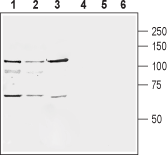Overview
- Peptide (C)ENFG(S)KLGSHGKR, corresponding to amino acid residues 365-377 of rat mGluR8 (Accession P70579). Extracellular, N-terminus.

 Western blot analysis of rat brain membranes (lanes 1 and 4), mouse brain membranes (lanes 2 and 5) and human SH-SY5Y neuroblastoma cell line lysate (lanes 3 and 6):1-3. Anti-mGluR8 (extracellular) Antibody (#AGC-028), (1:400).
Western blot analysis of rat brain membranes (lanes 1 and 4), mouse brain membranes (lanes 2 and 5) and human SH-SY5Y neuroblastoma cell line lysate (lanes 3 and 6):1-3. Anti-mGluR8 (extracellular) Antibody (#AGC-028), (1:400).
4-6. Anti-mGluR8 (extracellular) Antibody, preincubated with mGluR8 (extracellular) Blocking Peptide (#BLP-GC028).
 Expression of mGluR8 in rat globus pallidusImmunohistochemical staining of immersion-fixed, free floating rat brain frozen sections using Anti-mGluR8 (extracellular) Antibody (#AGC-028), (1:100). A. Staining reveals expression of mGluR8 (red) in globus pallidus neurons (arrow) and their dendrites. B. The same section was also stained with DAPI (blue) revealing cell nuclei. C. Merge of the two images.
Expression of mGluR8 in rat globus pallidusImmunohistochemical staining of immersion-fixed, free floating rat brain frozen sections using Anti-mGluR8 (extracellular) Antibody (#AGC-028), (1:100). A. Staining reveals expression of mGluR8 (red) in globus pallidus neurons (arrow) and their dendrites. B. The same section was also stained with DAPI (blue) revealing cell nuclei. C. Merge of the two images.
- Conn, P.J. et al. (1997) Annu. Rev. Pharmacol. Toxicol. 37, 205.
- Somogyi, J. et al. (2004) Eur. J. Neurosci. 19, 552.
- Saugstad, J.A. et al. (1997) Mol. Pharmacol. 51, 119.
- Zhai, J. et al. (2002) Neuropharmacology 43, 223.
Metabotropic glutamate receptors (mGluRs), heptahelical transmembrane receptors coupled to G-proteins, contribute to the regulation of neuronal excitability and synaptic transmission1. Genes coding for eight mGluRs (denoted mGluR1-8) with different splice variants have been identified and classified into three groups based on sequence homology, pharmacology, and signaling pathways. Group I mGluRs (mGluR1 and mGluR5) are primarily located postsynaptically. Group II (mGluR2 and mGluR3) are present both postsynaptically and presynaptically outside the release site. Group III mGluRs (mGluR4, mGluR6, mGluR7, and mGluR8) couple to Gαi/o to inhibit adenylyl cyclase found in the presynaptic active zone2.
The mGluR8 receptor is detected in the olfactory bulb, thalamus, pontine gray, cerebral cortex, hippocampus, cerebellum, and retina3. Electrophysiological studies suggest that mGluR8 functions as a presynaptic autoreceptor to regulate glutamate release from the lateral perforant path terminals in the mouse dentate gyrus4. It is suggested that mGluR8, like other group III mGluRs, controls glutamate release by inhibiting voltage-gated Ca2+ channels.
Targeted deletion of the mGluR8 gene in mice produces subtle behavioral alterations such as reduced habituation to novelty, hyperactivity, context-dependent but not cue-dependent disruption of the freezing response in the fear conditioning test, and increased anxiety5.
Application key:
Species reactivity key:
Alomone Labs is pleased to offer a highly specific antibody directed against an extracellular epitope of rat mGluR8. Anti-mGluR8 (extracellular) Antibody (#AGC-028) can be used in western blot and immunohistochemistry applications. It has been designed to recognize mGluR8 from rat, mouse and human samples.
